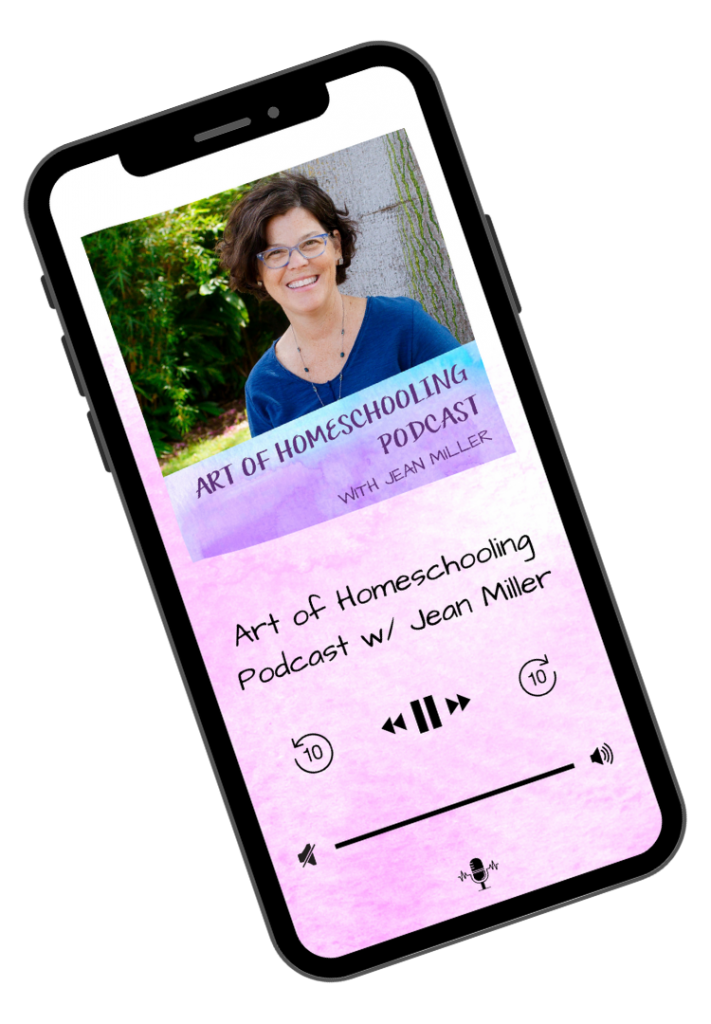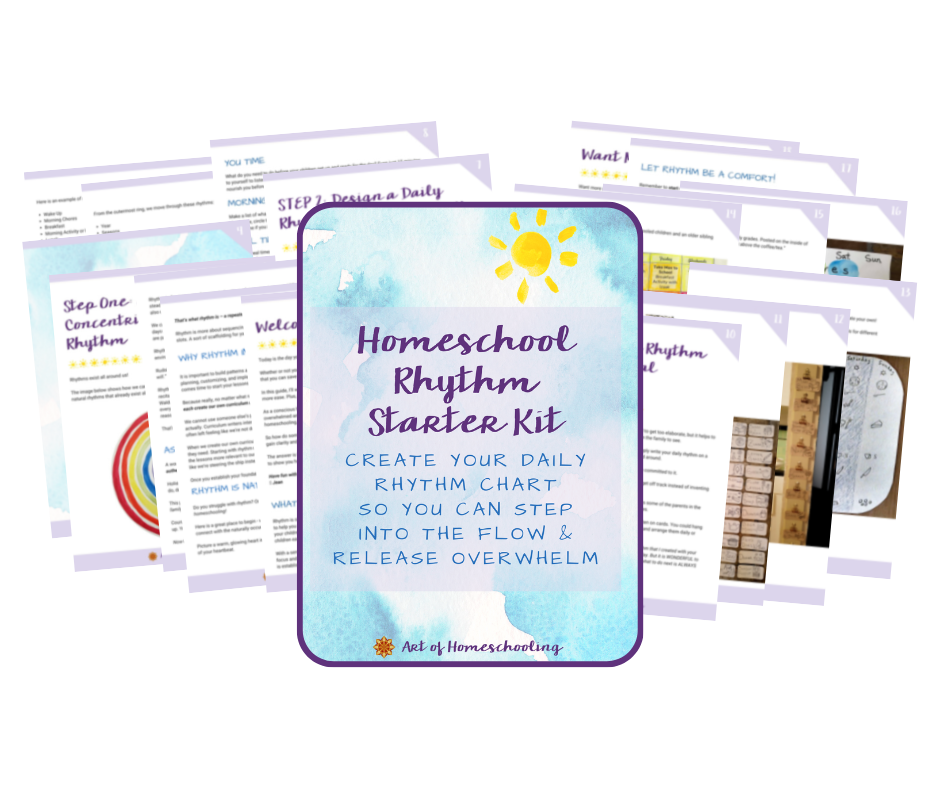Episode 107
Welcome to Episode #107 of the Art of Homeschooling Podcast, all about how to set up for main lesson block learning! Here on the show notes page, you’ll find highlights from the episode as well as links and resources. But you might be wondering, “What is a main lesson block, anyway?”
So let’s jump in!
The easiest way to bring main lesson block learning to your homeschool is to plan for a block or unit of study that’s anywhere from three to six weeks, during which one subject is the focus. These main lesson blocks can be holistic and interdisciplinary, with the arts, sciences, history, and literature interwoven into the topic of the block.
The topics for these main lesson blocks are chosen to suit a child’s developmental stage. Rudolf Steiner, the founder of Waldorf education back in 1919, created a list of main lesson block topics by grade that many schools and homeschoolers refer to today.
These topics have evolved over the years, of course. And as homeschoolers, we have flexibility in choosing block topics to suit our own children.
Check out the resources below to find a traditional list of Waldorf main lesson blocks.
Let’s Look at The Morning Main Lesson…
The main lesson generally takes place each morning for about an hour or two. One topic is the focus during main lesson time. For example, animal fables, farming and gardening, or ancient civilizations.
So what exactly does a main lesson look like in a homeschool setting?
Here’s a description!
The Set Up for Main Lesson Block Learning
Let’s start with the supplies. Here are some supplies you might want to have on hand:
- a chalkboard for drawing and writing a story summary
- index cards with poems and verses and songs on them for warm-up time
- a basket of bean bags
- the story material for the day from a book of your choosing
- an idea of the drawing(s) you’ll do to highlight the story
- some modeling beeswax to keep little hands busy during the storytelling
- recorders for music
- a candle to create a mood of reverence
The Sequence of the Main Lesson
Now for a description of main lesson learning in action. Here’s what a homeschool day might look like using this approach.
- To begin, you might show that it’s time to start lessons by playing a tune on a recorder, penny whistle, wooden pentatonic flute. (It’s better than hollering up the stairs, believe me!)
- Next comes warm-up time or circle time, depending on the ages of your children. This movement time might include songs, clapping games, setting out rhymes, multiplication tables, bean bag tossing, or other playful movement activities. Foundational skills such as literacy, math, and spacial awareness are developed during this time.
- Now it’s time to light a candle and recite an opening verse to help create a focused and sincere mood for learning.
- Time to gather on the couch and we start with stories! From fairy tales, fables, and myths, to biographies and accounts of significant history events, stories help us connect with the learning in really authentic and engaging ways.
- After couch time, we move to the table to work on main lesson books. This is a way to record the learning that’s taken place. Main lesson books replace textbooks and worksheets in the Waldorf approach. And are a wonderful portfolio of your child’s learning journey and development through each grade and over the years.
- Main lesson work can include drawing a picture from the narrative material from that morning. Or you might choose to extend the lesson by reading or researching from a related book, doing a hands-on project, or activity.
- On the day after drawing the story and working artistically, it’s time to review the story and write a summary in the main lesson book.
- When the main lesson book work is complete, close your lesson with a closing verse, holding hands if your child is willing.
- Math practice, handwork skills, nature study, or other activities can follow this main lesson time, perhaps even after lunch.
The Importance of Rhythm
That’s the basic structure of a main lesson block. At its core is a two-day rhythm, where the first day is the story and an artistic activity, and the second day is review and summary writing.
The key rhythm to retain is presenting new material one day, sleeping on it, and then recalling that story or material the next day.
Now you know the answer to “what is a main lesson block?” The main lesson block encompasses all three of these key elements: teaching through story, artistic hands-on activity, and rhythm.
What I’ve loved most about main lesson block learning is how much my children stayed engaged. If there happened to be a block that was less interesting to them, I could add in some artistic activities that I knew they loved.
And, we got to start over every month or so. That way their interest stayed fresh (and so did mine!)
Does Main Lesson Block Learning Work?
And now you may be wondering, “Why does main lesson block learning work?”
Is there any evidence that this approach is effective?
As a matter of fact, many schools beyond the Waldorf movement are now realizing the benefits of block learning. Rather than change subjects every 45-50 minutes, these schools now extend learning over a longer block time, and stay with one topic for a number of weeks. Integrating subjects such as history, art, music, and writing into the one topic.
Studies show that retention is greater with hands-on learning over longer periods of time than with the traditional textbook and test approach.
Main Lesson Block Learning vs. Unit Studies
You might be familiar with unit studies for homeschooling. A unit study is sometimes called a thematic unit or an integrated study. They tend to be hands-on and focused on one particular topic.
The child learns by reading real books (referred to as “living books” in the Charlotte Mason approach), and experiencing or discovering about a topic through activities rather than just reading a chapter from a textbook.
So we can think of main lesson blocks as a specific type of unit study.
Here’s a little comparison of unit studies and main lesson blocks.
In main lesson blocks, there is a rhythm to the activities that is similar no matter what the topic is. For example, one of the traditional main lesson blocks in grade three is farming and gardening. In this block, children might start their day reciting verses and songs about farming and gardening. Then comes a story about the topic, perhaps from a culture of people who grow their own food. The story is followed by an artistic activity such as painting or drawing depicting a scene from the story.
The next day, the child writes a summary of the story into a book they create to record their learning. After this, children might do some gardening and planting themselves outdoors. In this way, language arts, history, science, and art are all woven into one unit of study.
On the other hand, typical homeschool unit studies incorporate as many different activities as possible, an eclectic mix of activities. The child might look up the topic in an encyclopedia, check a different reference book at the library, read a work of fiction on the topic, watch a documentary, memorize a poem on the subject, and then perhaps do some hands-on activity or craft.
To me, the main difference between a main lesson block and a unit study is summed up in this phrase that I like to use to describe main lesson block learning: “go deep, not wide.”
I would describe most unit studies as going wide, meaning the goal is to weave in as many different activities, subjects, and resources as possible.
In contrast, a main lesson block incorporates the activities in a particular rhythm. Learning is more of an experience rather than a collection of activities. This helps students learn in a very economical way that takes less time overall. And helps to deepen the learning.
Go deep, not wide.
~Jean Miller
Main Lesson Block Learning Works!
To summarize, main lesson block learning works because it:
- allows for extended time on a given subject
- gives children an opportunity to use their thinking in a concentrated manner
- uses the concept of rhythm to carry the learning energy forward
- integrates many subjects into one topic that speaks to the interest and developmental stage of the child at different ages and grades
Thanks so much for listening to this episode of the podcast! I hope you’ll embrace main lesson block learning in a way that brings more joyful experiences to your homeschool!
More Resources to Explore
If you’re looking for ongoing support, come join an amazing group of homeschoolers inside my mentorship community, Inspired at Home. Here, you’ll find the training and help you need to sustain your homeschooling journey. Included are an extensive library of masterclasses, group coaching calls, and a warm and welcoming community of homeschoolers.
You’ll find more about block learning here on Episode 90 of the podcast, Block Learning is Fantastic for Homeschooling And Here’s Why! If you’re ready for a deep dive into main lesson block learning, check it out!
Want to hear more about rhythm in homeschooling? Check out Episode #3: Relax Into Your Homeschool Rhythm.
This resource is a fantastic place to start exploring block planning with Waldorf-inspired homeschooling: Waldorf Block Rotation, Grades 1-8
Rate & Review the Podcast
If the Art of Homeschooling Podcast has inspired you, I’d LOVE it if you could rate and review the podcast on your favorite podcast player! Reviews can be left on Apple Podcasts (iTunes), Podcast Addict, or Stitcher.
Or simply pop on over to lovethepodcast.com/artofhomeschooling and choose where you want to leave your review.
And if you want to show your appreciation for the Art of Homeschooling Podcast, you can buy me a coffee!
Never Miss an Episode!


Check Out All the Episodes Here



